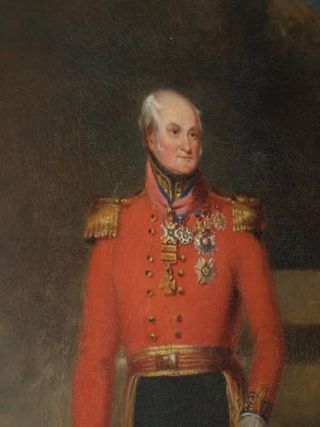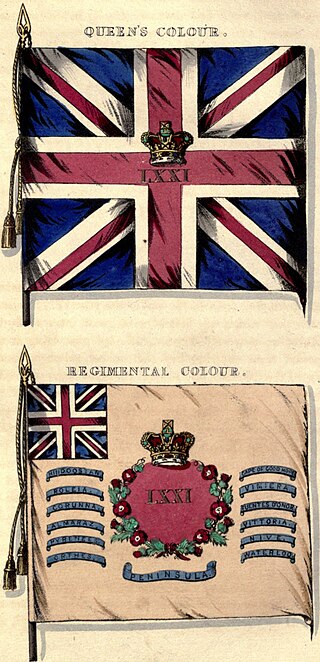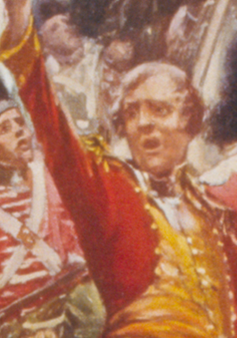
Lieutenant-General Sir Robert Arbuthnot, KCB was a British military commander during the Napoleonic Wars. He was a general in the army, a colonel in the 76th Regiment. He was a brigadier general in the Portuguese Service and was appointed a Knight of the Tower and Sword of Portugal (KTS).

General Sir Phineas Riall, KCH was the British general who succeeded John Vincent as commanding officer of the Niagara Peninsula in Upper Canada during the War of 1812. In 1816, he was appointed Governor of Grenada.

The 50th Regiment of Foot was an infantry regiment of the British Army, raised in 1755. Under the Childers Reforms it amalgamated with the 97th Regiment of Foot to form the Queen's Own Royal West Kent Regiment in 1881.

General Sir Charles Colville was a British Army officer who served during the Napoleonic Wars. He was an ensign in 1781. He served in the West Indies from 1791 to 1797 and while serving there was promoted to lieutenant-colonel (1796). He helped to suppress the Irish Rebellion of 1798. He was in Egypt in 1801 and fought at Martinique in 1809. He commanded brigade, and afterwards division, in the Peninsular War from 1810 until 1814. During the Waterloo Campaign of 1815 he commanded a division in Belgium and the same year was made a K.C.B. In 1819 he was promoted to lieutenant-general and served as commander-in-chief at Bombay from 1819 until 1825. He was governor of Mauritius from 1828 until 1834. He was promoted to general in 1837.

The 73rd Regiment of Foot was an infantry regiment of the British Army, raised in 1780. Under the Childers Reforms it amalgamated with the 42nd Regiment of Foot to form the Black Watch in 1881.

The 71st Regiment of Foot was a Highland regiment in the British Army, raised as the 73rd (Highland) Regiment of Foot in 1777. Under the Childers Reforms it amalgamated with the 74th (Highland) Regiment of Foot to become the 1st Battalion, Highland Light Infantry in 1881.

Major-General Sir Robert Henry DickKOV was a Scottish soldier, son of a medical doctor in the East India Company's service.

Lieutenant-General John Keane, 1st Baron Keane was an Irish soldier, whose military exploits in the First Anglo-Afghan War led to him being created Baron Keane of Ghuznee.
The 61st Regiment of Foot was an infantry regiment of the British Army, raised in 1756. Under the Childers Reforms it amalgamated with the 28th Regiment of Foot to form the Gloucestershire Regiment in 1881.

The 81st Regiment of Foot (Loyal Lincoln Volunteers) was an infantry regiment of the British Army, raised in 1793. Under the Childers Reforms it amalgamated with the 47th (Lancashire) Regiment of Foot to form the Loyal North Lancashire Regiment in 1881.
The 74th (Highland) Regiment of Foot was a British Army line infantry regiment, raised in 1787. Under the Childers Reforms it amalgamated with the 71st (Highland) Regiment of Foot to form the Highland Light Infantry in 1881.
General Sir John Oswald was a prominent British Army officer during the French Revolutionary and Napoleonic Wars whose service was conducted in seven different theatres of war. Oswald was born in Fife and educated in France, which gave him both excellent command of the French language and close connections with the French aristocracy. The excesses of the French Revolution gave him a hatred of the French Republic and later Empire, and his exemplary service in the West Indies, the Netherlands, Malta, Italy, Egypt, the Adriatic and finally the Peninsular War demonstrated both his keen tactical and strategic understanding his and personal courage.

Lieutenant-General Sir Joseph Thackwell was a British Army officer. He served with the 15th Hussars in the Peninsular War at the Battle of Sahagún in 1808 and the Battle of Vitoria in 1813, and he lost his left arm at the Battle of Waterloo in 1815. He commanded the regiment from 1820 to 1832. He then served in India, commanding the cavalry in the First Anglo-Afghan War of 1838–89, and at the Battle of Sobraon in the First Anglo-Sikh War of 1845–46, and at the Battle of Chillianwala and Battle of Gujrat in the Second Anglo-Sikh War of 1848–9. He also commanded the 3rd The King's Own Dragoons, was colonel of the 16th Lancers, and was appointed Inspector-general of cavalry.
Colonel Sir William Robe was a British Army officer of the Royal Artillery who served in the Revolutionary and Napoleonic Wars. He was praised as an artillery commander in combat and an organiser of military operations, as well as starting the first regimental school for soldiers' children, and serving as the architect of Quebec's Anglican cathedral.

General Sir Alexander Cameron was a Scottish general officer of the British Army, known for his service in the Rifle Brigade.

Lieutenant-General Sir Neil Douglas was a British Army officer who fought at the 1815 Battle of Waterloo and later became Commander-in-Chief, Scotland.

Lieutenant General Sir James Holmes Schoedde KCB was a British Army officer who became colonel of the 2nd Regiment of Foot and the 55th Regiment of Foot.
Major-General Sir John George Woodford was a British Army officer who has been called "possibly the first battlefield archaeologist". He served in the Napoleonic Wars, and in 1818, did archaeological work in the area surrounding the Battle of Agincourt.

General Lord Mark Ralph George Kerr GCB was a British Army officer who served in the Crimean War and in India.

Lieutenant-General Sir Robert Lawrence Dundas was a British Whig and military commander during the Peninsular War. He was a Member of Parliament in the House of Commons representing Malton from 1807 to 1812, East Retford from 1826 to 1827, and Richmond from 1828 to 1834 and from 1839 to 1841.














